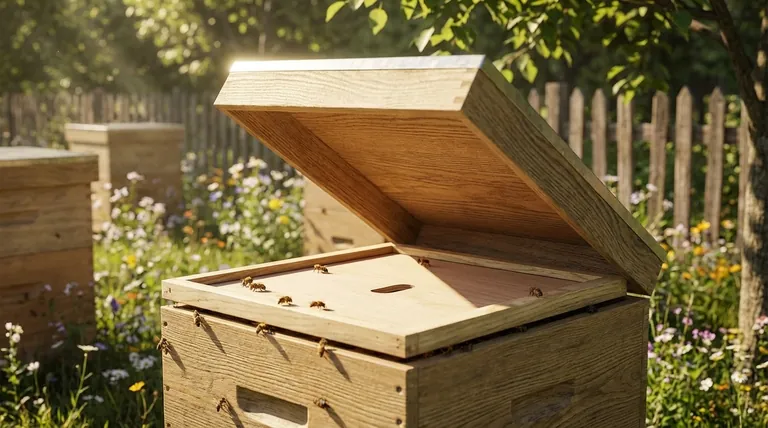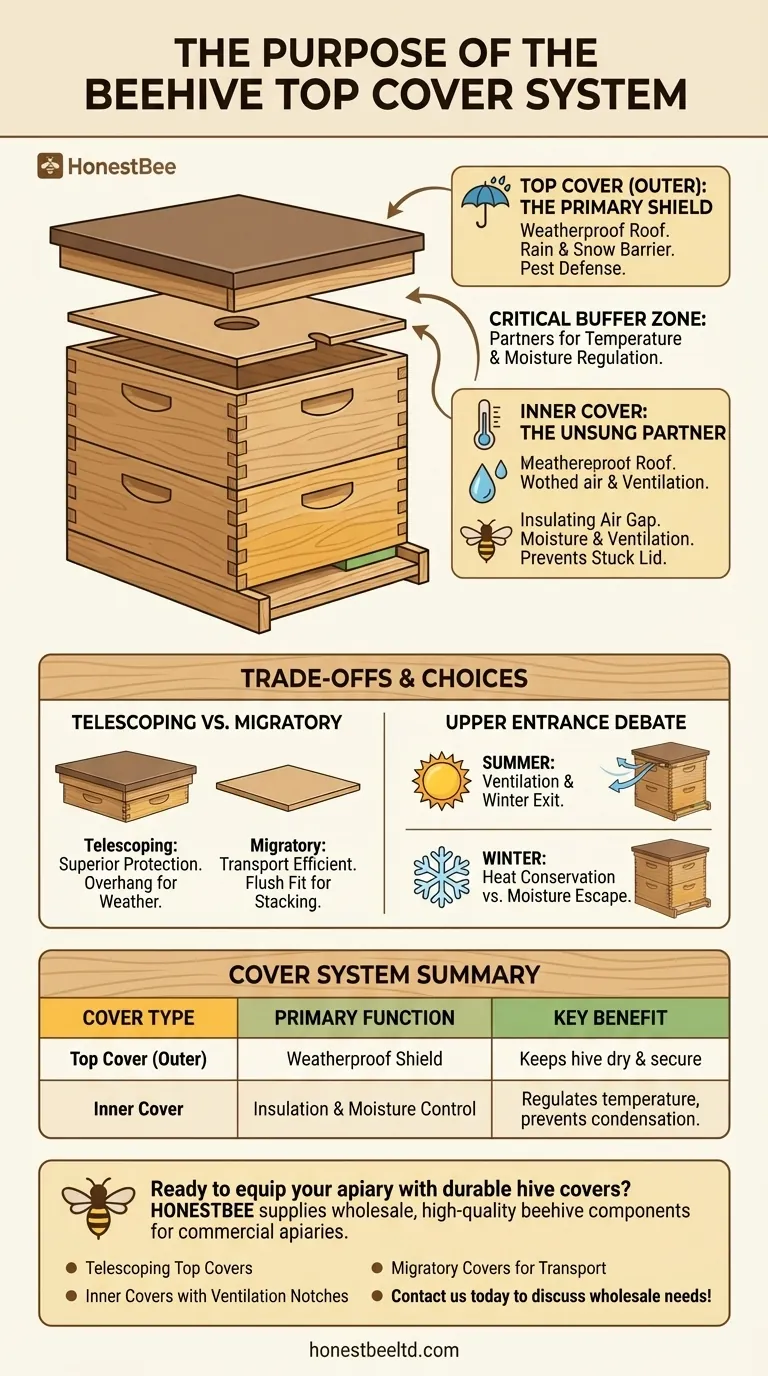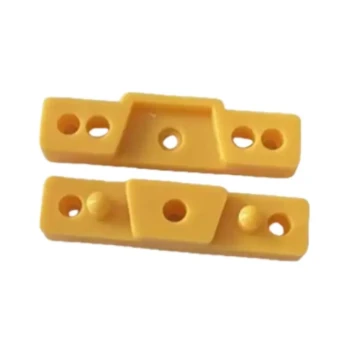The primary purpose of a beehive top cover is to serve as the hive's main shield against the elements. It is the first line of defense that keeps rain, snow, and direct sun from entering the hive, ensuring the colony remains dry and protected from external threats like pests.
The top cover is the hive's weatherproof roof, but its true function is realized only when it works in partnership with the inner cover. Together, they create a critical buffer zone that helps the bees regulate their internal temperature and moisture.

The Top Cover's Role as the Primary Shield
The top cover, also called the outer cover, is the most straightforward component of the hive, but its protective function is non-negotiable for the colony's survival.
Protection From Weather
The most critical job of the top cover is to make the hive waterproof. Rainwater entering a hive can chill the brood and spoil honey stores, leading to disease and colony collapse.
A common and effective design is the telescoping top cover. This style overhangs the top hive box, covering the seam between the top cover and the box below to prevent water from dripping inside.
Defense Against Intruders
By securely capping the top of the hive, the top cover creates a physical barrier. This prevents pests, from small insects to larger animals, from gaining easy access to the colony and its resources.
The Inner Cover: The Unsung Partner
To fully understand the top cover, you must understand the inner cover it rests upon. This thin board sits directly on the top hive box, just beneath the outer cover, and plays a vital role in managing the hive's internal environment.
Creating an Insulating Air Gap
The inner cover creates a pocket of dead air between itself and the outer top cover. This air gap acts as a crucial layer of insulation.
In summer, it shields the colony from the intense heat of direct sunlight hitting the top cover. In winter, it helps reduce heat loss, preventing the warm, moist air inside the hive from directly contacting the cold surface of the outer cover.
Managing Moisture and Ventilation
Condensation is a major threat to a wintering colony. The inner cover is designed to help manage it. It often has a small notch on its rim that provides an upper entrance for ventilation.
This small exit allows excess moisture to escape the hive, preventing it from condensing, freezing, and dripping back down onto the bees. It also gives bees an alternative entrance if the main bottom entrance is blocked by snow.
Preventing a Stuck Lid
Bees use a sticky resin called propolis to seal every crack and gap inside their hive. Without an inner cover, the bees would firmly glue the top cover directly to the hive box below.
The inner cover provides a "break point," preventing the bees from sealing the outer cover down. This makes hive inspections far less disruptive for the colony and much easier for the beekeeper.
Understanding the Trade-offs
While the top and inner cover system is highly effective, its configuration involves balancing different hive management priorities.
The Upper Entrance Debate
The upper entrance notch in the inner cover is excellent for summer ventilation and provides a winter exit. However, it can also be a point of heat loss.
Some beekeepers choose to close this upper entrance during the coldest parts of winter to conserve as much heat as possible, especially in well-insulated hives.
Telescoping vs. Migratory Covers
The telescoping cover offers superior weather protection due to its overhanging design. This makes it ideal for stationary hives in climates with significant rainfall.
In contrast, a migratory cover sits flush with the sides of the hive. It offers less weather protection but allows hives to be stacked tightly together on pallets for commercial pollination, prioritizing transport efficiency over maximum protection.
Making the Right Choice for Your Goal
Your goals as a beekeeper will determine how you utilize your hive covers.
- If your primary focus is maximum weather protection: A telescoping top cover is the definitive choice to keep the hive dry in all conditions.
- If your primary focus is ventilation and moisture control: Ensure your inner cover has a ventilation notch and is positioned correctly to allow humid air to escape.
- If your primary focus is ease of inspection: Never operate a hive without an inner cover, as it is the key to preventing a propolis-sealed outer cover.
Ultimately, using the top and inner covers as an integrated system is fundamental to providing a stable, secure, and healthy home for your bees.
Summary Table:
| Cover Type | Primary Function | Key Benefit |
|---|---|---|
| Top Cover (Outer) | Weatherproof shield | Keeps hive dry and secure from elements |
| Inner Cover | Insulation & moisture control | Regulates temperature and prevents condensation |
Ready to equip your apiary with durable, weather-resistant hive covers?
At HONESTBEE, we supply commercial apiaries and beekeeping equipment distributors with wholesale-focused, high-quality beehive components designed for maximum colony protection and ease of use.
Let us help you optimize your hive management:
- Telescoping top covers for superior weather protection
- Inner covers with ventilation notches for optimal moisture control
- Migratory covers for efficient transport in commercial operations
Contact us today to discuss your wholesale needs and ensure your bees have a stable, healthy home!
Visual Guide

Related Products
- Inner Beehive Cover for Beekeeping Bee Hive Inner Cover
- Professional Insulated Winter Hive Wrap for Beekeeping
- Acrylic Lid Beekeeping Honey Extractor for Beekeepers
- Long Langstroth Style Horizontal Top Bar Hive for Wholesale
- Stainless Steel Beekeeping Honey Extractor Lid
People Also Ask
- What is the role of the inner cover in a beehive? Essential Climate Control for Hive Health
- What is the recommended orientation for the rim of an inner cover? Master Hive Ventilation and Insulation
- What is the role of inner covers in insulated beehives? Master Moisture Control for a Healthy Colony
- What is the function of the center hole in the inner cover? Master Hive Ventilation and Feeding
- What is the purpose of the inner cover in a beehive? A Key to Hive Health & Easy Management



















